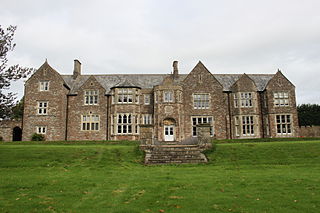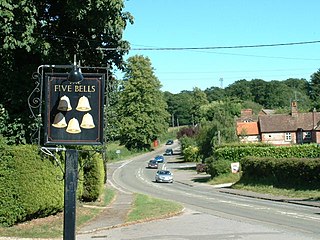
Addington is a village and area in south London, England, within the London Borough of Croydon. It is south of Spring Park, west of Coney Hall, north of New Addington and east of Forestdale and Selsdon, and is 11.1 miles (18 km) south of Charing Cross and 4 miles (6.4 km) south-east of the centre of Croydon.

Lacock Abbey in the village of Lacock, Wiltshire, England, was founded in the early 13th century by Ela, Countess of Salisbury, as a nunnery of the Augustinian order. The abbey remained a nunnery until the suppression of Roman Catholic institutions in England in the 16th century; it was then sold to Sir William Sharington who converted the convent into a residence where he and his family lived. It was fortified and remained loyal to the crown during the English Civil War, but surrendered to the Parliamentary forces once Devizes had fallen in 1645.

West Wickham is an area of South East London, England, in the London Borough of Bromley. It lies south of Park Langley,Eden Park Beckenham and Bromley town center, west of Hayes and north of Coney Hall, east of Spring Park and Shirley. 10.3 miles (16.6 km) south-east of Charing Cross on the line of a Roman road, the London to Lewes Way. Before the creation of Greater London in 1965, West Wickham was in Kent.

Baconsthorpe Castle, historically known as Baconsthorpe Hall, is a ruined, fortified manor house near the village of Baconsthorpe, Norfolk, England. It was established in the 15th century on the site of a former manor hall, probably by John Heydon I and his father, William. John was an ambitious lawyer with many enemies and built a tall, fortified house, but his descendants became wealthy sheep farmers, and being less worried about attack, developed the property into a more elegant, courtyard house, complete with a nearby deer park.

Tabley House is an English country house in Tabley Inferior, some 3 kilometres (1.9 mi) to the west of the town of Knutsford, Cheshire. The house is recorded in the National Heritage List for England as a designated Grade I listed building. It was built between 1761 and 1769 for Sir Peter Byrne Leicester, to replace the nearby Tabley Old Hall, and was designed by John Carr. The Tabley House Collection exists as an exhibition showcased by the University of Manchester.

Clevedon Court is a manor house on Court Hill in Clevedon, North Somerset, England, dating from the early 14th century. It is owned by the National Trust and is designated as a Grade I listed building.

Hylton Castle is a stone castle in the North Hylton area of Sunderland, Tyne and Wear, England. Originally built from wood by the Hilton family shortly after the Norman Conquest in 1066, it was later rebuilt in stone in the late 14th to early 15th century. The castle underwent major changes to its interior and exterior in the 18th century and it remained the principal seat of the Hylton family until the death of the last Baron in 1746. It was then Gothicised but neglected until 1812, when it was revitalised by a new owner. Standing empty again until the 1840s, it was briefly used as a school until it was purchased again in 1862. The site passed to a local coal company in the early 20th century and was taken over by the state in 1950.

Capesthorne Hall is a country house near the village of Siddington, Cheshire, England. The house and its private chapel were built in the early 18th century, replacing an earlier hall and chapel nearby. They were built to Neoclassical designs by William Smith and (probably) his son Francis. Later in the 18th century, the house was extended by the addition of an orangery and a drawing room. In the 1830s the house was remodelled by Edward Blore; the work included the addition of an extension and a frontage in Jacobean style, and joining the central block to the service wings. In about 1837 the orangery was replaced by a large conservatory designed by Joseph Paxton. In 1861 the main part of the house was virtually destroyed by fire. It was rebuilt by Anthony Salvin, who generally followed Blore's designs but made modifications to the front, rebuilt the back of the house in Jacobean style, and altered the interior. There were further alterations later in the 19th century, including remodelling of the Saloon. During the Second World War the hall was used by the Red Cross, but subsequent deterioration prompted a restoration.

East Barsham Manor is an important work of Tudor architecture, a leading and early example of a prodigy house, originally built in the 1520s. It is located in the village of East Barsham, about 2.5 miles (4.1 km) north of the town of Fakenham and 2.1 miles (3.4 km) south west of the village of Walsingham in the English county of Norfolk. It is protected as a Grade I listed building.

Sutton Court is an English house remodelled by Thomas Henry Wyatt in the 1850s from a manor house built in the 15th and 16th centuries around a 14th-century fortified pele tower and surrounding buildings. The house has been designated as Grade II* listed building.

Burton Agnes Hall is an Elizabethan manor house in the village of Burton Agnes, near Driffield in the East Riding of Yorkshire, England. It was built by Sir Henry Griffith in 1601–10 to designs attributed to Robert Smythson. The older Norman Burton Agnes Manor House, originally built in 1173, still stands on an adjacent site; both buildings are now Grade I listed buildings.

Sir Geoffrey Boleyn was an English merchant and politician who served as Lord Mayor of London from 1457 to 1458. He purchased the manor of Blickling, near Aylsham, in Norfolk from Sir John Fastolf in 1452, and Hever Castle in Kent in 1462. He was the great-grandfather of Queen Anne Boleyn, the mother of Queen Elizabeth I. Sir Geoffrey built the domestic, mercantile and civic fortunes of the Boleyn family, and raised its status from the provincial gentry, as his brother Thomas Boleyn made a career of distinction in church and university, together building the family's wealth, influence and reputation.

Wickham is a village about 5.5 miles (8.9 km) north-west of Newbury, Berkshire, England. The M4 motorway passes just north of it. It is in the civil parish of Welford.

The Grove is a large hotel in Hertfordshire, England, with a 300–acre (1.2 km2) private park next to the River Gade and the Grand Union Canal. It touches on its north-west corner the M25 motorway and remains a small part in Watford. The estate is situated within three different settlements; most of the land and all of the mansion itself are in the civil parish of Sarratt, and also in the ecclesiastical parish of Langleybury, while the estate lies within the post town of Rickmansworth.

Chesterton is a village and civil parish on Gagle Brook, a tributary of the Langford Brook in north Oxfordshire. The village is about 1+1⁄2 miles (2.4 km) southwest of the market town of Bicester. The village has sometimes been called Great Chesterton to distinguish it from the hamlet of Little Chesterton, about 3⁄4 mile (1.2 km) to the south in the same parish. The 2011 Census recorded the parish population as 850.

Eleanor Manners, Countess of Rutland, was lady-in-waiting to five wives of King Henry VIII of England: Anne Boleyn, Jane Seymour, Anne of Cleves, Catherine Howard, and Catherine Parr.
Sir Henry Heydon was the son of John Heydon of Baconsthorpe, Norfolk, 'the well-known opponent of the Paston family'. He married Anne Boleyn, the daughter of Sir Geoffrey Boleyn, great-grandfather of Henry VIII's queen Anne Boleyn.

The Church of St John the Divine is in Burnley Road, Holme Chapel, a village in the civil parish of Cliviger, near Burnley, Lancashire, England. It is an active Anglican parish church in the diocese of Blackburn, and the church is recorded in the National Heritage List for England as a designated Grade II listed building. It was built between 1788 and 1794, replacing a small chapel, and is in simple Classical style. Above the west front is a bell turret with an octagonal cupola, and inside the church are carved oak stalls, moved from a demolished church, which include a poppyhead and misericords.
Green Street House, usually known as Boleyn Castle, was a stately home in East Ham in the modern London Borough of Newham, East London.

The Little Thatch is a 14th-century timber-framed building at 141 Bristol Road, Quedgeley, Gloucester. It is now used as a public house and hotel.



















